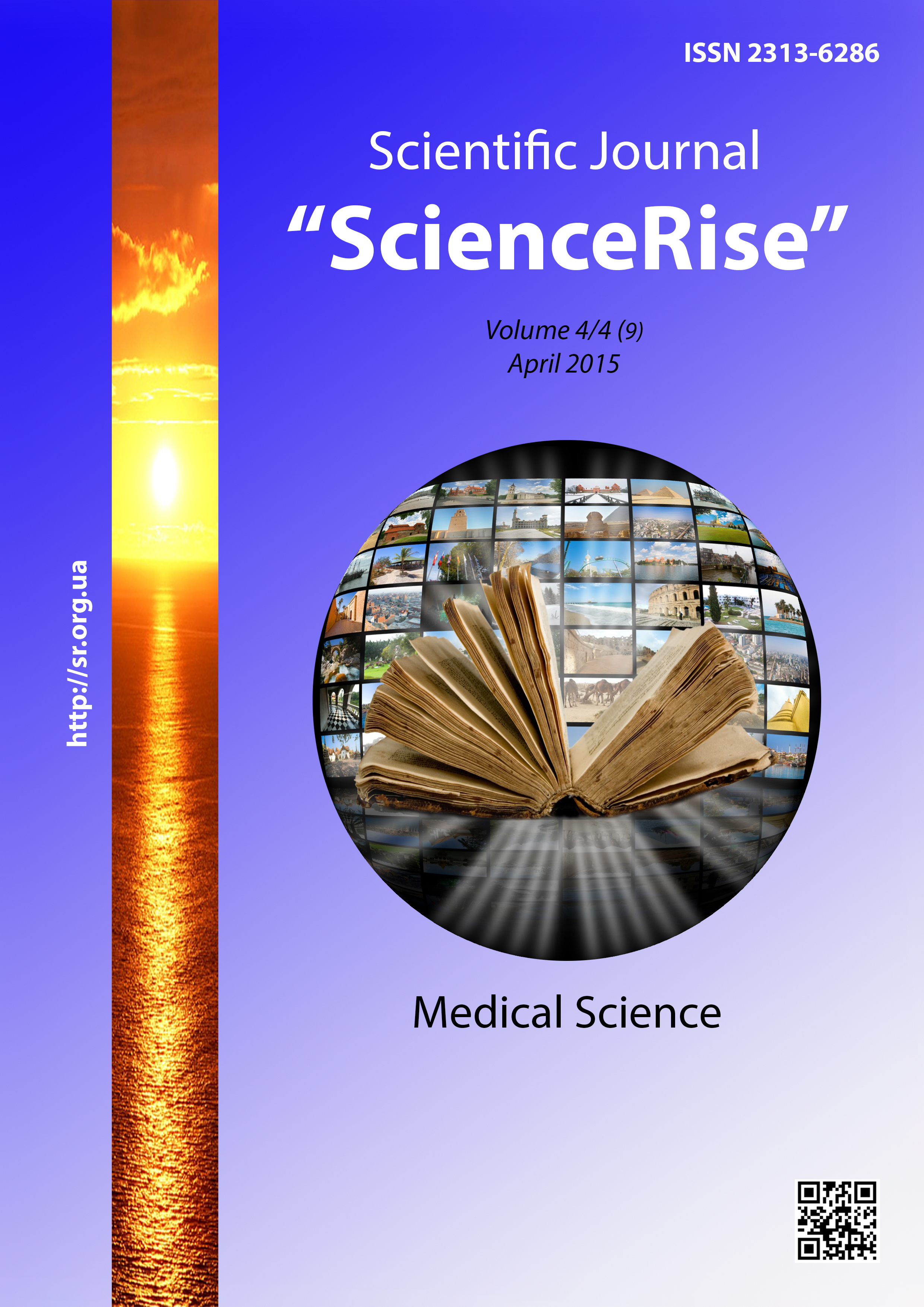Carney’s triad: difficulties in the diagnosis
DOI:
https://doi.org/10.15587/2313-8416.2015.41741Keywords:
Carney triad, gastrointestinal stromal tumor, pulmonary hamartoma (chondroma), extraaadrenal paraganglioma, diagnosisAbstract
Carney's triad is a rare non-hereditary condition characterized by gastrointestinal stromatic tumors (GIST, intramural mesenchymal tumors of the gastrointestinal tract with neuronal or neural crest of the cell origin), pulmonary chondromas and extraadrenal paragangliomas. Less than 100 cases have been reported worldwide. Carney's triad primarily affects young women (it means the age of early 20-s). Most patients initially have two of the three tumors (incomplete Carney's triad). The main symptoms at presentation are gastrointestinal bleeding, epigastric pain, anemia and palpable abdominal mass. These symptoms are related to the GIST, which occur in 99% of cases. Pulmonary chondromas (well-differentiated benign cartilaginous tumors) occur in approximately 80% of cases. They are often asymptomatic and may be unilateral (83%) or bilateral (32%). Secreting paragangliomas (typically extraadrenal and most often mediastinal) occur in approximately 50% of patients. The etiology is not completely understood.
A case of Carney triad, which caused some difficulty and complexity of the diagnosis at the initial stage of case management.
Due to the complex of diagnostic search, errors in the definitive diagnosis of the Triad Carney were found in almost all clinical cases, which are associated with diverse clinical diagnosis and complexities of individual nosology: gamartohondromy lung or gastrointestinal stromal tumor, or extraadrenal paraganglioma, and their combination in one patient in complete or incomplete.
Thus, in this case, a combination of lung hamartomas and neuroendocrine tumor of the duodenum - gastrointestinal stromal tumor gives rise to diagnosis.References
Carney, J. A. (1979). The triad of gastric epitheloid leiomyosarcoma, functioning extra-adrenal paraganglioma, and pulmonary chondroma. Cancer, 43 (1), 374–382. doi: 10.1002/1097-0142(197901)43:1<374::aid-cncr2820430152>3.0.co;2-t
Stratakis, C. A., Carney, J. A. (2009). The triad of paragangliomas, gastric stromal tumours and pulmonary chondromas (Carney triad), and the dyad of paragangliomas and gastric stromal sarcomas (Carney-Stratakis syndrome): molecular genetics and clinical implications. Journal of Internal Medicine, 266 (1), 43–52. doi: 10.1111/j.1365-2796.2009.02110.x
Carney, J. A., Hruska, L. S., Beauchamp, G. D., Gordon, H. (1986). Dominant Inheritance of the Complex of Myxomas, Spotty Pigmentation, and Endocrine Overactivity. Mayo Clinic Proceedings, 61 (3), 165–172. doi: 10.1016/s0025-6196(12)61843-6
Carney, J. A., Gordon, H., Carpenter, P. C., Shenoy, B. V., Go, V. L. (1985). The complex of myxomas, spotty pigmentation, and endocrine overactivity. Medicine (Baltimore), 64, 270–283.
Vidaillet, H. J. Jr., Seward, J. B., Fyke, E., Tajik, A. J. (1984). Name syndrome (nevi, atrial myxoma, myxoid neurofibroma, ephelides): a new and unrecognized subset of patients with cardiac myxoma. Minn Med., 6 (12), 695–696.
Kirschner, L. S., Carney, J. A., Pack, S. D. (2000). Mutations of the gene encoding the protein kinase A type I-alpha regulatory subunit in patients with the Carney complex. Nat Genet., 26, 89–92.
Alamjan, A. A., Chalimov, A. Z., Kudaibergenova, I. O., Romashov, Yu. V. (1989).Mnozhestvennie gamartomi legkogo. Voprosi onkologii, 2, 227–229.
Vasoljev, S. A., Burkov, V. P. (1992). Bistrorastuzhaja gamartoma legkogo. Voprosi onkologii, 4, 500–502.
Ragulin, Yu. A., Lantsov, D. S., Malik, S. S., Medvedev, V. N. (2006). Recidiv gamartomi legkogo s endobronchialnim rostom. Grudnaja i serdechno-sosudisnaja chirurgia, 3, 67–69.
Koshkarov, V. N. (1985). Morfogenes I patologicheskaya anatomia perifericheskich gamartom legkich. Krasnodar, 20.
Samsonov, V. A. (1991). Lipomatosnaya gamartoma broncha. Archiv patologii, 8, 55–56.
Pikunov, M. Yu. (2004). Mnozhestvennie chondromatoznie gamartomi legkich.Chirurgia, 9, 66–67.
Carney, J. A., Hruska, L. S., Beauchamp, G. D., Gordon, H. (1986). Dominant Inheritance of the Complex of Myxomas, Spotty Pigmentation, and Endocrine Overactivity. Mayo Clinic Proceedings, 61 (3), 165–172. doi: 10.1016/s0025-6196(12)61843-6
Kubishkin, B. A., Buriev, I. M., Abdulkerimov, Z. A. (2004). Neiroendokrinnie nefuntsioniruyuschie opucholi podsheludochnoi shelezi.Chirurgia. Shurnal imeni Pirogova, 3, 4–9.
Orlova, E. M., Kareva, M. A. (2012). Karni-komplex – sindrom mnozhestvennich endokrinnich neoplasii. Promlemi endokrinilogii, 58 (3), 22–30.
Cimmerman, Ja. S. (2009). Neiroendokrinnie opucholi podsheludochnoi shelezi I sheludochno-kishechnogo trakta. Кlinicheskaya medicina, 12, 7–13.
Rhodes, A. R., Silverman, R. A., Harrist, T. J., Perez-Atayde, A. R. (1984). Mucocutaneous lentigines, cardiomucocutaneous myxomas, and multiple blue nevi: the "LAMB" syndrome. Journal of the American Academy of Dermatology, 10 (1), 72–82.
Alrashdi, I., Bano, G., Maher, E. R., Hodgson, S. V. (2010). Carney triad versus Carney Stratakis syndrome: two cases which illustrate the difficulty in distinguishing between these conditions in individual patients.Fam Cancer., 9 (3), 443–447. doi: 10.1007/s10689-010-9323-z
Downloads
Published
Issue
Section
License
Copyright (c) 2015 Ирина Юрьевна Ватанская, Татьяна Игнатьевна Cтепаненко, Светлана Владимировна Ярцева, Елена Степановна Оленицкая, Галина Васильевна Мякоткина, Наталия Анатольевна Соколова, Инна Петровна Стрекозова, Лилия Владимировна Нетруненко

This work is licensed under a Creative Commons Attribution 4.0 International License.
Our journal abides by the Creative Commons CC BY copyright rights and permissions for open access journals.
Authors, who are published in this journal, agree to the following conditions:
1. The authors reserve the right to authorship of the work and pass the first publication right of this work to the journal under the terms of a Creative Commons CC BY, which allows others to freely distribute the published research with the obligatory reference to the authors of the original work and the first publication of the work in this journal.
2. The authors have the right to conclude separate supplement agreements that relate to non-exclusive work distribution in the form in which it has been published by the journal (for example, to upload the work to the online storage of the journal or publish it as part of a monograph), provided that the reference to the first publication of the work in this journal is included.

